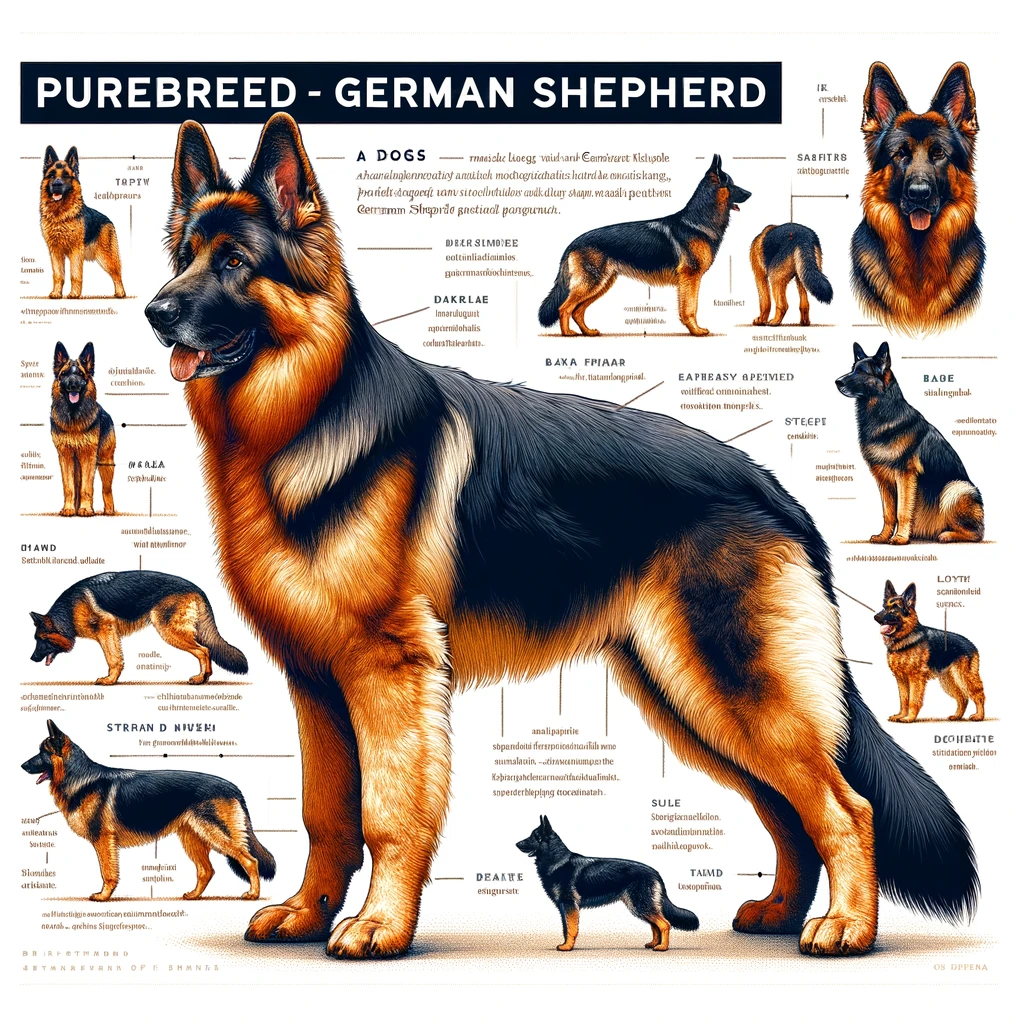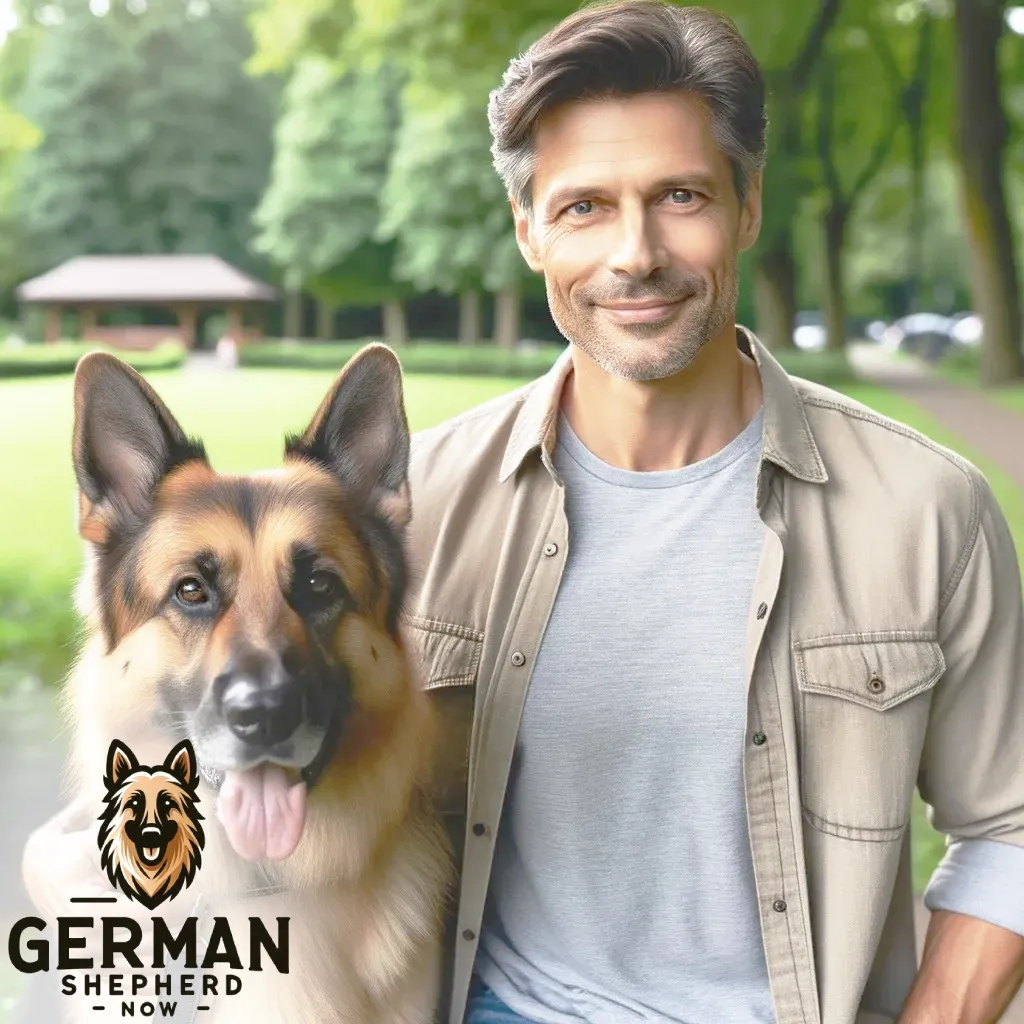How to Identify a Purebred German Shepherd: What Are the Signs?

To identify a purebred German Shepherd, look for key physical characteristics such as a strong, muscular build, a straight back, and a bushy tail that hangs down and curves slightly at the bottom. Their coat should be dense and come in various colors, though the most common are tan/black or red/black with a black mask and body markings.
Purebred German Shepherds have a distinct head shape with a long, square-cut muzzle and medium-sized, almond-shaped eyes that are dark in color.
Their ears are large, stand erect, and open at the front, and they exhibit a confident and alert demeanor. Official documentation from a reputable breeder or kennel club, like AKC registration, is a reliable way to confirm a dog’s purebred status.
1. Physical Characteristics
Purebred German Shepherds exhibit distinct physical characteristics that set them apart from other breeds. These characteristics include:
Strong, Muscular Build: One of the defining features of a purebred German Shepherd is its robust and muscular physique. They have a well-proportioned body with a strong bone structure, indicating their breed purity.
Straight Back: German Shepherds should have a straight back, a crucial sign of their breed. Avoid dogs with a hunched or curved back, as this may indicate mixed breeding.
Bushy Tail: Look for a bushy tail hanging down and slightly curving at the bottom. This tail shape is typical of purebred German Shepherds.
2. Coat Colors
German Shepherds come in various coat colors, but there are specific color patterns that are more common in purebreds:
Tan/Black or Red/Black: The most prevalent coat colors of Purebred German Shepherds are tan/black or red/black. These dogs have distinct black markings on a tan or red base.
Black Mask and Body Markings: A purebred German Shepherd often has a black mask covering its face and black markings on its body. These markings are a characteristic feature.
3. Head Shape
The head of a German Shepherd is another key indicator of their breed purity:
Long, Square-Cut Muzzle: Purebred German Shepherds have a distinctive head shape with a long, square-cut muzzle. This muzzle shape is one of their recognizable traits.
Almond-Shaped Eyes: Their eyes are medium-sized and almond-shaped. They typically have dark-colored eyes that contribute to their alert and intelligent expression.
4. Ears
The ears of a German Shepherd are a prominent feature:
Large, Erect Ears: Look for large ears that stand erect and open at the front. The upright position of their ears is a characteristic of purebred German Shepherds.
5. Demeanor and Documentation
In addition to physical traits, a purebred German Shepherd’s demeanor and official documentation can confirm its breed status:
Confident and Alert Demeanor: Purebred German Shepherds are known for their confident and alert behavior. They exhibit intelligence and attentiveness.
Official Documentation: To ensure a dog’s purebred status, obtaining official documentation from a reputable breeder or kennel club is essential. For example, registration with the American Kennel Club (AKC) is a reliable way to confirm a dog’s purebred lineage.
Identifying a Fake German Shepherd
German Shepherds are a popular breed known for their intelligence, loyalty, and distinctive appearance. There are instances where dogs may be misrepresented as purebred German Shepherds when they are not.
1. Inaccurate Physical Characteristics
One of the primary signs of a fake German Shepherd is inaccurate physical characteristics. These may include a hunched back, a lack of a bushy tail, and irregular coat colors or patterns. Genuine German Shepherds have a specific breed standard that dictates their physical appearance, so deviations from this standard may indicate a fake.
2. Absence of Documentation
Authenticating a German Shepherd’s pedigree often requires proper documentation. If the seller cannot provide official paperwork, such as registration papers from a reputable kennel club like the AKC (American Kennel Club), it raises suspicions about the dog’s authenticity.
3. Behavioral Differences
Purebred German Shepherds are known for their specific temperament traits, including intelligence, protectiveness, and trainability. A fake German Shepherd may exhibit behavioral differences, such as excessive aggression or timidity, which are not typical of the breed.
4. Unreliable Sources
Avoid purchasing a German Shepherd from unreliable or unlicensed breeders or sellers. Reputable breeders adhere to strict breeding standards and prioritize the health and authenticity of their dogs. Buying from unverified sources increases the risk of obtaining a fake German Shepherd.
5. Genetic Testing
For ultimate confirmation, consider genetic testing. DNA tests can determine a dog’s lineage and breed composition accurately. Genetic testing can provide conclusive evidence if you doubt your German Shepherd’s authenticity.
FAQs About how to identify a purebred GSD
In this guide, we present 10 frequently asked questions and their answers to help you understand how to identify a purebred German Shepherd.
- What are the key physical characteristics of a purebred German Shepherd?
- Key physical characteristics include a strong, muscular build, a straight back, a bushy tail that curves slightly at the bottom, and a dense coat with common color variations like tan/black or red/black with a black mask.
- What should I look for in the head of a purebred German Shepherd?
- A purebred German Shepherd’s head should have a long, square-cut muzzle, medium-sized almond-shaped eyes that are dark in color, and large ears that stand erect and open at the front.
- Can a purebred German Shepherd have a different coat color?
- While the most common coat colors are tan/black or red/black, purebred German Shepherds can have other colors, but deviations from the standard may indicate mixed breeding.
- What is the temperament of a purebred German Shepherd?
- Purebred German Shepherds are known for their intelligence, loyalty, protectiveness, and trainability. They typically exhibit a confident and alert demeanor.
- How can I verify if a German Shepherd is purebred?
- Official documentation from a reputable breeder or kennel club, like AKC registration, is a reliable way to confirm a dog’s purebred status.
- Are there any specific markings I should look for on a purebred German Shepherd?
- Purebred German Shepherds may have distinct body markings, such as a black mask and body markings, but these can vary.
- What are common signs of a mixed-breed German Shepherd?
- Signs of mixed breeding may include physical characteristics that deviate from the breed standard, irregular coat colors, and behavioral traits inconsistent with the breed’s temperament.
- Is it possible for a purebred German Shepherd to have a different tail shape?
- A purebred German Shepherd’s tail should have a bushy appearance and curve slightly at the bottom. A different tail shape could indicate mixed breeding.
- Why is it important to identify a purebred German Shepherd?
- Identifying a purebred German Shepherd ensures you get a dog with predictable traits and characteristics, which can be essential for specific purposes like working dogs or companionship.
- Should I consider genetic testing to confirm a dog’s purebred status?
- Genetic testing can provide conclusive evidence of a dog’s lineage and breed composition, making it a reliable option if you doubt its purity.
Conclusion: Ensuring the Authenticity of Your GSD
Identifying a purebred German Shepherd is crucial for those seeking a dog with the breed’s unique traits and characteristics. In this guide, we’ve explored key physical features, coat colors, head shape, and demeanor to help you confirm a dog’s purity.
Official documentation from reputable sources, such as kennel clubs, is a valuable verification tool.
Furthermore, we’ve emphasized the importance of caution when dealing with potential fake German Shepherds. Inaccurate physical characteristics, lack of documentation, behavioral differences, and unreliable sources are warning signs. Genetic testing is the ultimate method to confirm a dog’s breed composition with certainty.
By applying the information and guidelines in this guide, you can identify and welcome a genuine purebred German Shepherd into your family, ensuring a rewarding and fulfilling companionship.

I’m Martin, and I grew up in the super cool city of Seattle. You know, the place with all the incredible mountains and forests? Yeah, that’s my playground!
Ever since I was little, I’ve been all about nature. I used to wander around the woods with a notebook, doodling all the cool plants and animals I’d find.
